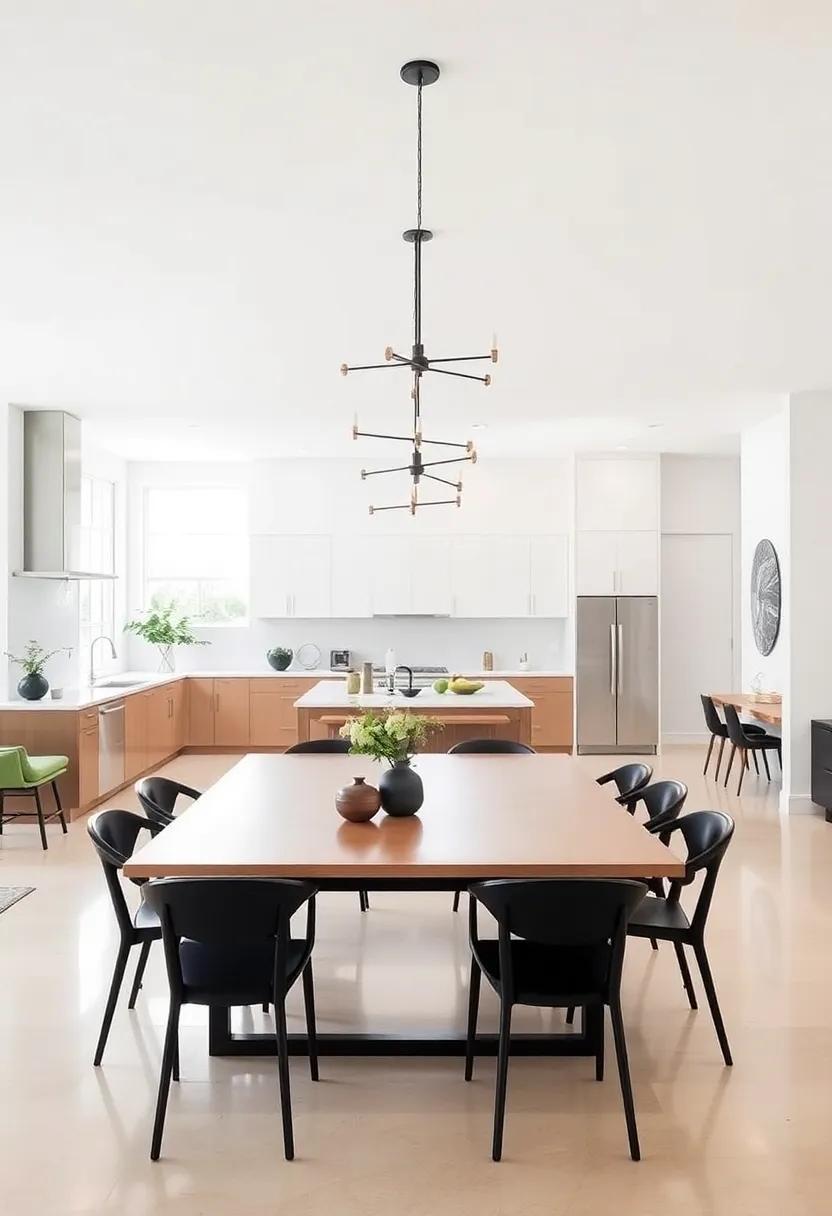In an era where the boundaries of our living spaces are becoming increasingly blurred,the integration of kitchen,dining,and living areas has emerged as a celebrated trend in modern design. ”” invites you to explore the beauty and practicality of these fluid environments that foster both togetherness and individual expression. With an emphasis on seamless transitions and thoughtful arrangements, this article delves into how the unification of these three vital spaces not only enhances aesthetic appeal but also elevates the functionality of daily life. Join us as we uncover the art of creating harmonious open spaces that invite connection, inspire creativity, and embrace the joy of shared moments.
Exploring the Concept of Open Spaces in Modern Home Design
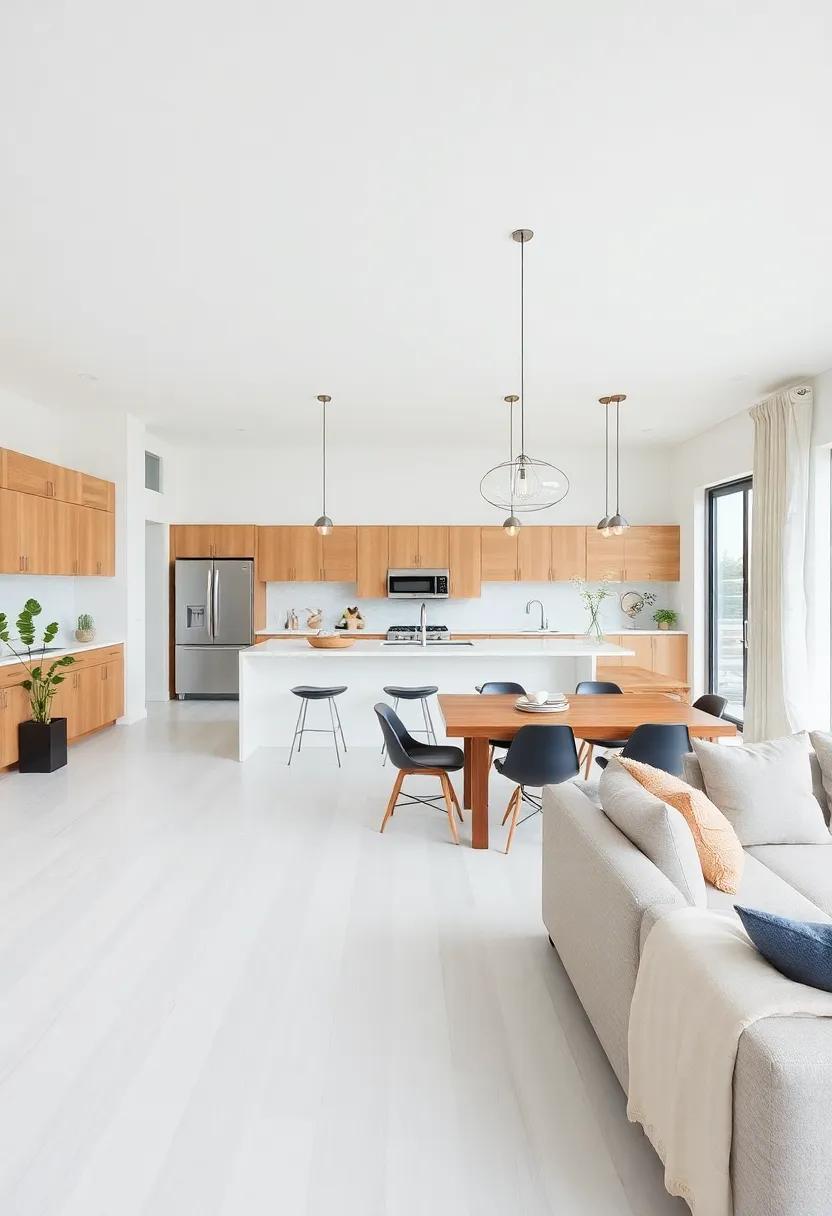
In recent years, the shift towards open spaces in modern home design has revolutionized the way we perceive our living areas. By removing walls and creating fluid transitions between the kitchen, dining, and living room, homeowners can cultivate an environment that promotes both interaction and functionality. Elements that enhance this concept include:
- Natural light,achieved through large windows or sliding glass doors.
- Strategic furniture placement that encourages dialog and connectivity.
- Unified colour schemes and materials that create a cohesive aesthetic.
This open layout fosters an inviting atmosphere where family gatherings and social events can thrive. the absence of physical barriers allows for versatility in how spaces are used, adapting effortlessly to different activities and moods. Furthermore, incorporating intelligent storage solutions helps in maintaining an uncluttered look, ensuring that the elegance of open space is not compromised. For inspiration on how to harmoniously blend these areas, consider visiting Architectural digest for the latest trends and ideas.
the Benefits of Merging Kitchen, Dining, and Living Areas
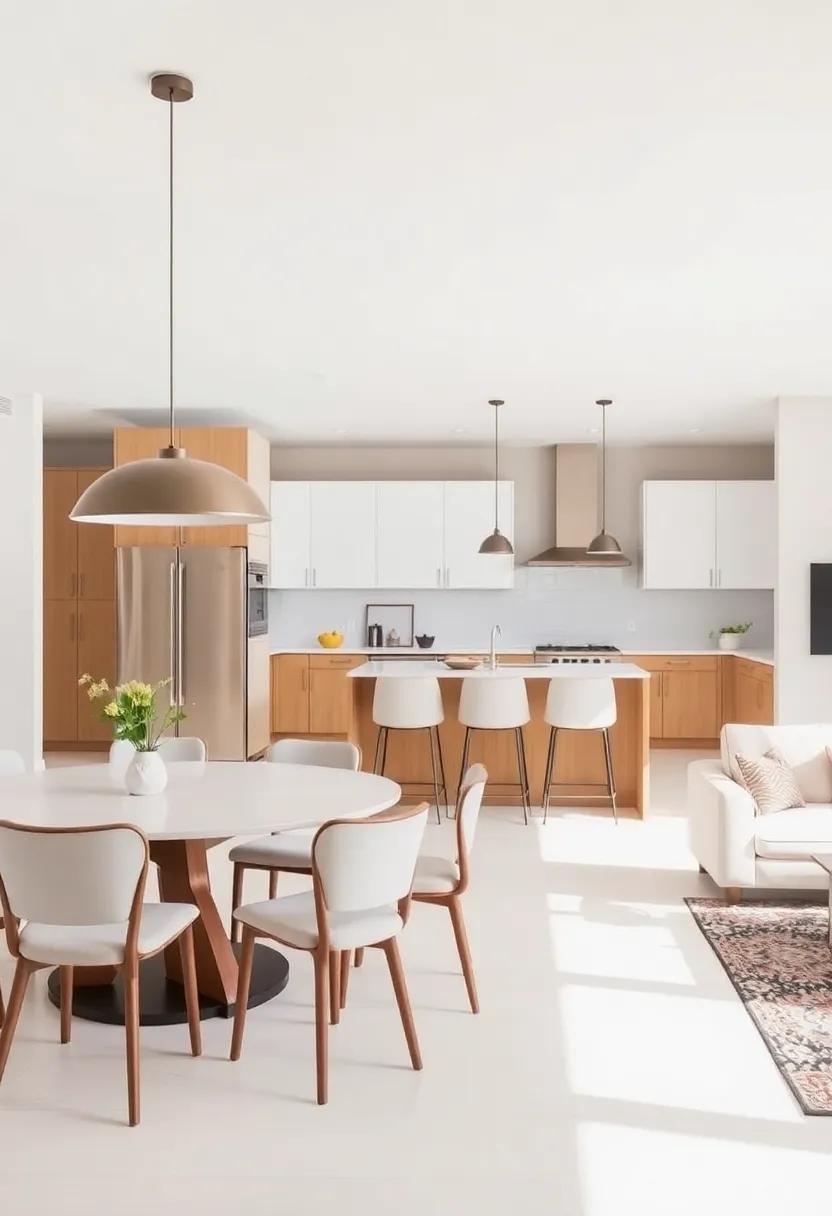
the fusion of kitchen, dining, and living areas cultivates a seamless flow that enhances both aesthetics and functionality in modern homes. This design approach promotes natural light, creating warm, inviting spaces that seem larger and more open. The integrated layout encourages social interaction, making it easier for family and friends to engage, weather cooking, dining, or relaxing. Without walls dividing these essential areas,the atmosphere becomes more dynamic and versatile,accommodating everything from casual gatherings to elegant dinner parties.
Moreover, embracing this open-style living fosters practicality and eases daily routines. in an interconnected space, tasks become more efficient; as an example, the ability to quickly move from prepping food to serving it creates a smoother flow during meal times. Additionally, this layout allows for creative versatility in décor and furniture choices, enabling homeowners to reflect their personal style. To explore how open-concept designs can transform your living experience, visit Houzz for inspiration and expert advice.
Creating Fluidity: Connecting Spaces for a Seamless Experience
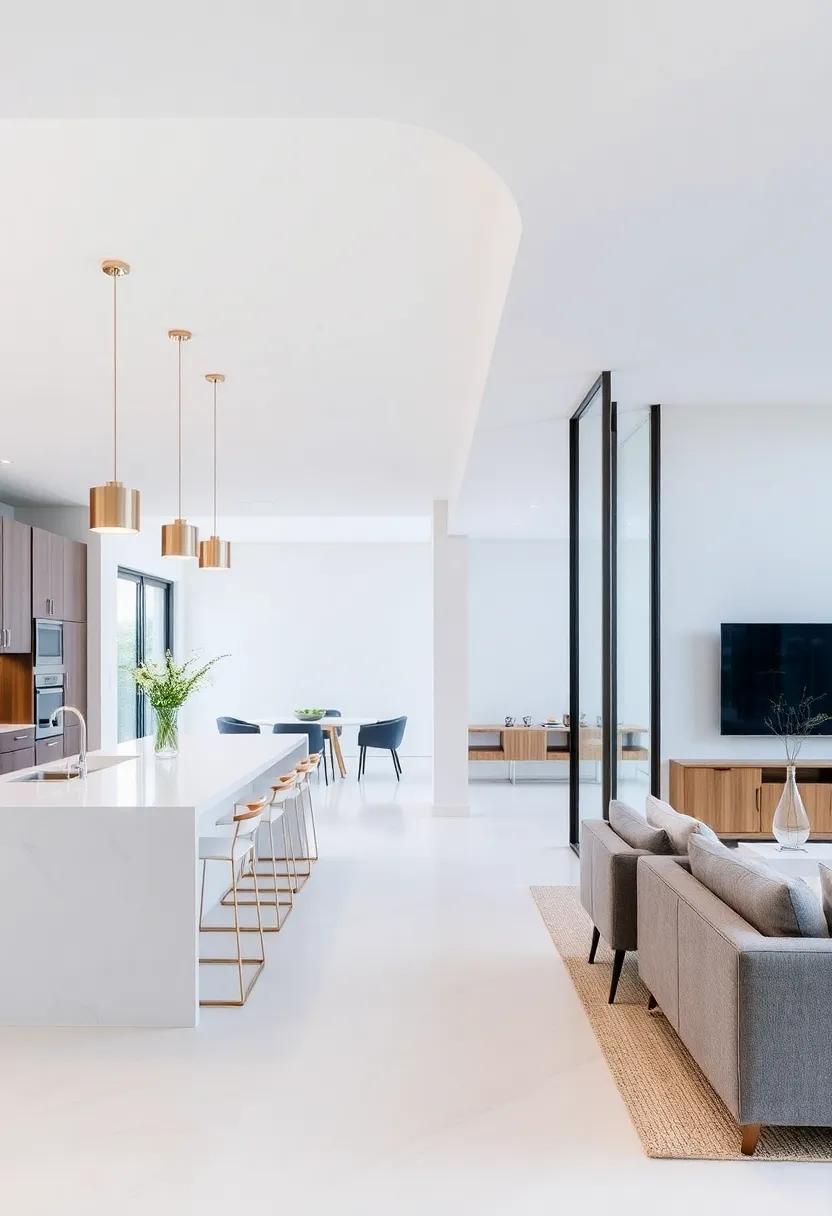
In a world where sanctuary and functionality coalesce, the integration of kitchen, dining, and living areas emerges as a beacon of modern design beliefs. Fluidity invites inhabitants to engage with their space in a manner that fosters connection and encourages interaction. The seamless transition between these areas not only cultivates a sense of community but also allows for versatile aesthetics, with decor that flows effortlessly throughout.Key elements to consider include:
- Color Palette: Use a cohesive color scheme to maintain a harmonious look.
- Materials: Incorporate natural materials like wood and stone for a welcoming ambiance.
- Lighting: Choose layered lighting solutions to enhance each space’s functionality.
This interconnectedness can be further enhanced through the strategic design of furniture layout. Open layouts enable the use of defining elements—such as area rugs, shelving, and decorative screens—that create boundaries without sacrificing visibility or accessibility. Consider creating a visual flow by arranging seating in conversational clusters and positioning dining areas adjacent to kitchens for easy serving and enjoying of meals. For those seeking inspiration and real-life examples, House Lovely offers an array of designs that exemplify this stylish unity. A well-thought-out approach can transform everyday living into an elegant choreography of space, promoting both aesthetic pleasure and an enriching living experience.
Choosing the Right Color Palette for Harmonious Living
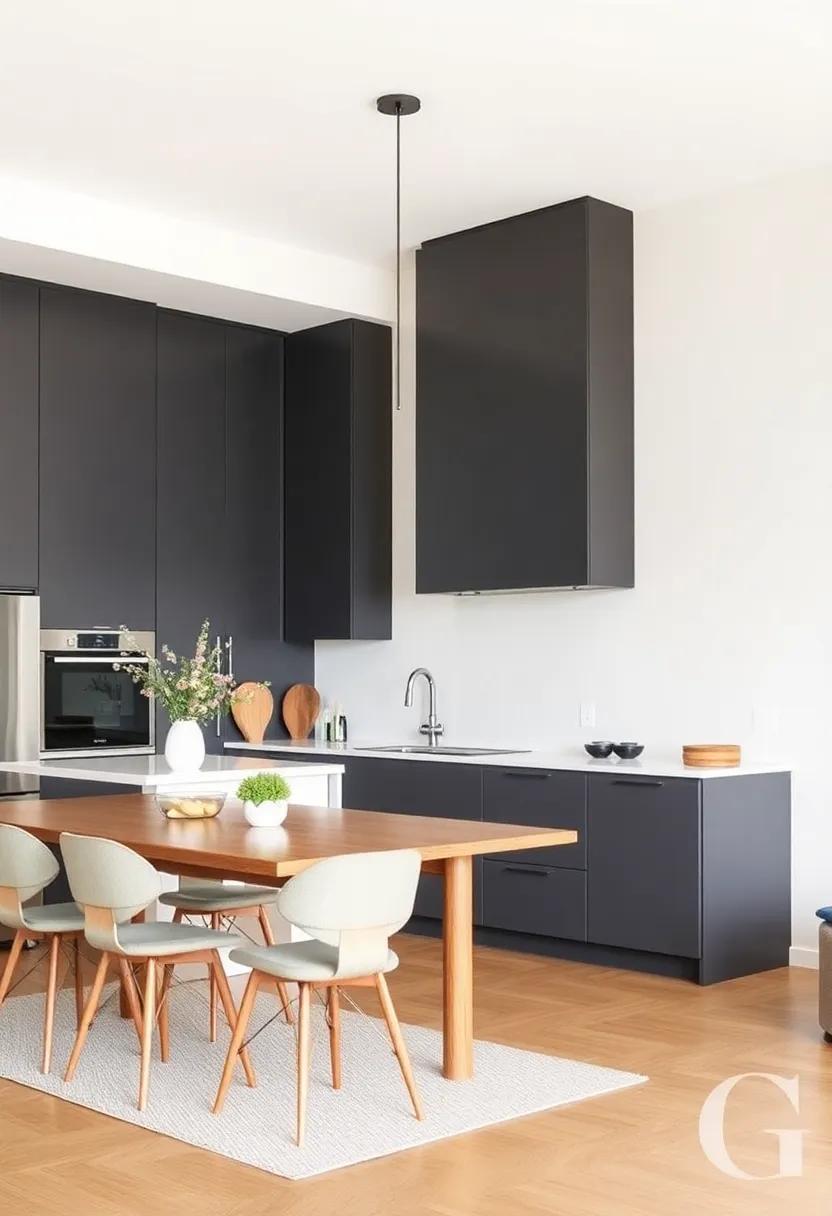
- Warm tones: Embrace earthy colors like terracotta and muted yellows to evoke a sense of warmth.
- Cool shades: Soft blues and greens can create a refreshing atmosphere,perfect for a modern aesthetic.
- Accent colors: Use vibrant shades such as coral or navy to create focal points without overwhelming the space.
To derive inspiration from nature, consider utilizing color theories like the 60-30-10 rule, which suggests that 60% of your space should be a dominant neutral base, 30% in a secondary hue, and 10% in an accent shade. A well-structured color table can help visualize your esquema:
| Color Category | Suggested Colors | Purpose |
|---|---|---|
| Base | Beige, Light Gray | Creating a calming backdrop |
| Secondary | Soft Sage, Dusty Blue | Adding depth and interest |
| Accent | Cinnamon, Teal | Providing striking focal points |
Incorporating intentional color choices not only enhances the aesthetic appeal but also supports emotional well-being. To delve deeper into color psychology and inspiration, visit Color Matters.
Furniture Arrangements That Inspire Conversation and Interaction

Creating a warm and inviting space is essential for encouraging interaction among family and friends. Strategically placing furniture can transform your kitchen, dining, and living areas into a social hub. Consider these elements when arranging your spaces:
- Open Layouts: Remove barriers by choosing flowing designs that connect the kitchen, dining, and living spaces.
- Conversation Circles: Arrange seating to face one another. Sofas and chairs should invite guests into the conversation.
- Versatile Tables: Use multi-functional tables that can serve as dining surfaces or game tables to foster interaction.
Incorporating these elements not only boosts engagement but ensures that your spaces feel cohesive. A well-planned arrangement serves as a backdrop for culinary experiences and memorable gatherings. As an example, mixing modern and vintage pieces can create visual interest, drawing guests into the environment. Consider using a central focal point, like a striking chandelier or a vibrant piece of artwork, to anchor the room. Here’s a handy overview:
| Furniture Type | Placement Tips |
|---|---|
| Sofa | Position it facing the dining area to facilitate flow and discussions. |
| dining Table | Keep it close to the kitchen for easy serving and connection. |
| Accent Chairs | Scatter them around for cozy seating options that invite conversation. |
For more inspiration on open space arrangements, check out Houzz.
Lighting Techniques That Elevate Open space Ambiance
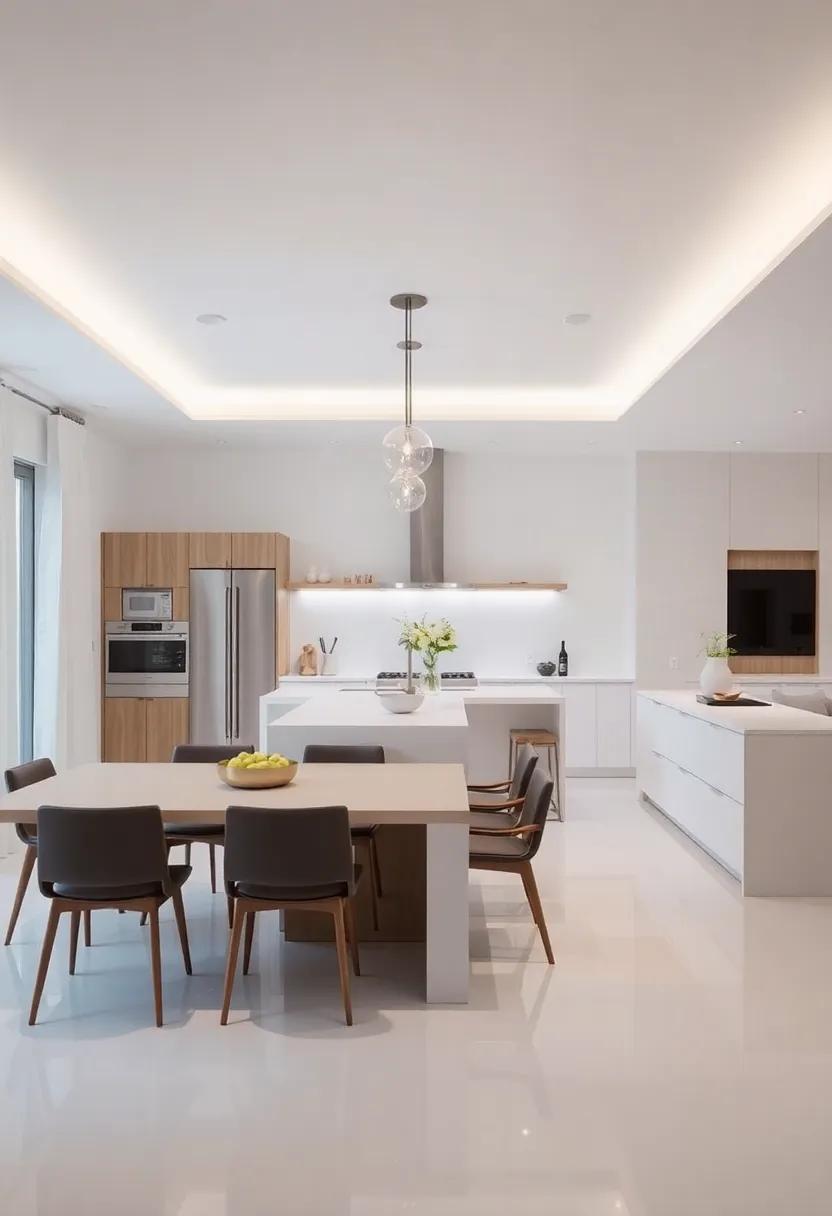
In open spaces where the kitchen, dining, and living areas converge, the right lighting techniques can transform the ambiance, enhancing both functionality and aesthetic appeal. Layering lights is essential; a combination of ambient,task,and accent lighting creates a versatile and inviting environment. As a notable example, recessed lighting can serve as the perfect ambient backdrop, ensuring the room is well-lit without overwhelming brightness. Adding pendant lights over the dining table not only provides focused illumination for meals but also acts as a decorative statement piece. Incorporating dimmers can further define the mood, allowing flexibility from luminous family gatherings to cozy, intimate dinners.
Another effective approach is utilizing natural light to its fullest potential.Large windows or strategically placed mirrors can help reflect light, making the space feel larger and brighter. Consider the use of warm LED bulbs, which can create a welcoming glow, enhancing the warm tones of your decor. To create eye-catching focal points, use wall sconces or table lamps in unique designs that complement the overall theme of your open space. integrating smart lighting technology offers the ability to adjust your environment seamlessly, bringing together functionality and style with just a tap or voice command. For more ideas, explore resources on Houzz.
Making the Most of Natural Light in Open Living Areas
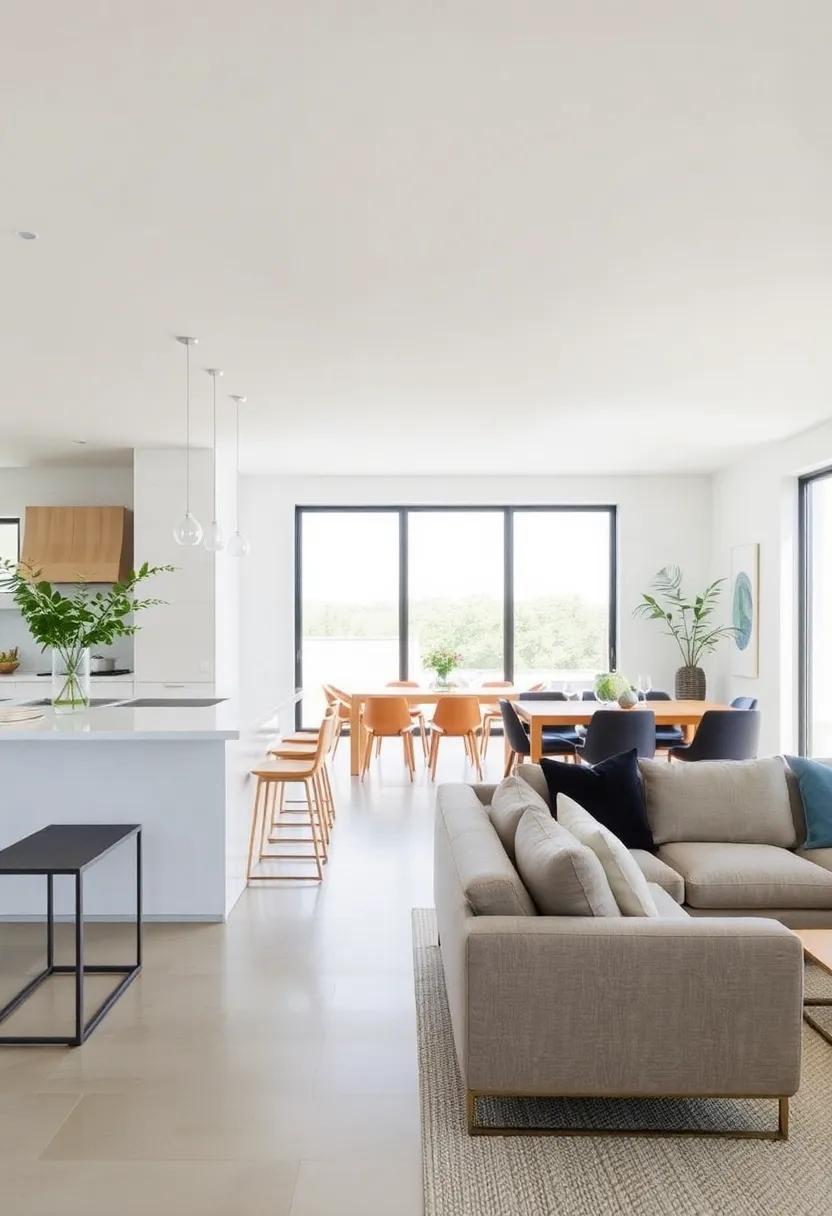
In open living areas, maximizing natural light is essential for creating a warm and inviting atmosphere. Consider incorporating large windows that stretch from floor to ceiling, allowing sunlight to flood the space. Mirrors can also play a crucial role; strategically placing them opposite windows can reflect light and make your area feel more expansive. To enhance the effect of natural light, choose light-colored furnishings and decor, which will bounce light around the room and create an airy feel. Some additional tips include:
- using sheer curtains to filter light while maintaining privacy.
- Opting for glass doors that connect indoor and outdoor spaces.
- Incorporating skylights to bring in sunlight from above.
it’s also beneficial to consider how you arrange furniture in relation to light sources. Creating an open layout allows sunlight to travel unobstructed across the room. Avoid heavy, dark furniture, which can absorb light and make spaces feel smaller. Instead, incorporate multifunctional pieces that serve both aesthetic and practical purposes, like a light wood coffee table or a glass dining set. To visualize how different elements interact with natural light, here is a simple guide:
| Element | Impact on Light |
|---|---|
| Mirrors | Reflect light, creating depth |
| Light Colors | Enhance brightness |
| glass Surfaces | Allow light to pass through |
for more inspiration on utilizing natural light effectively in your open space, visit Houzz.
Incorporating Multi-Functional Furniture for Ultimate Versatility
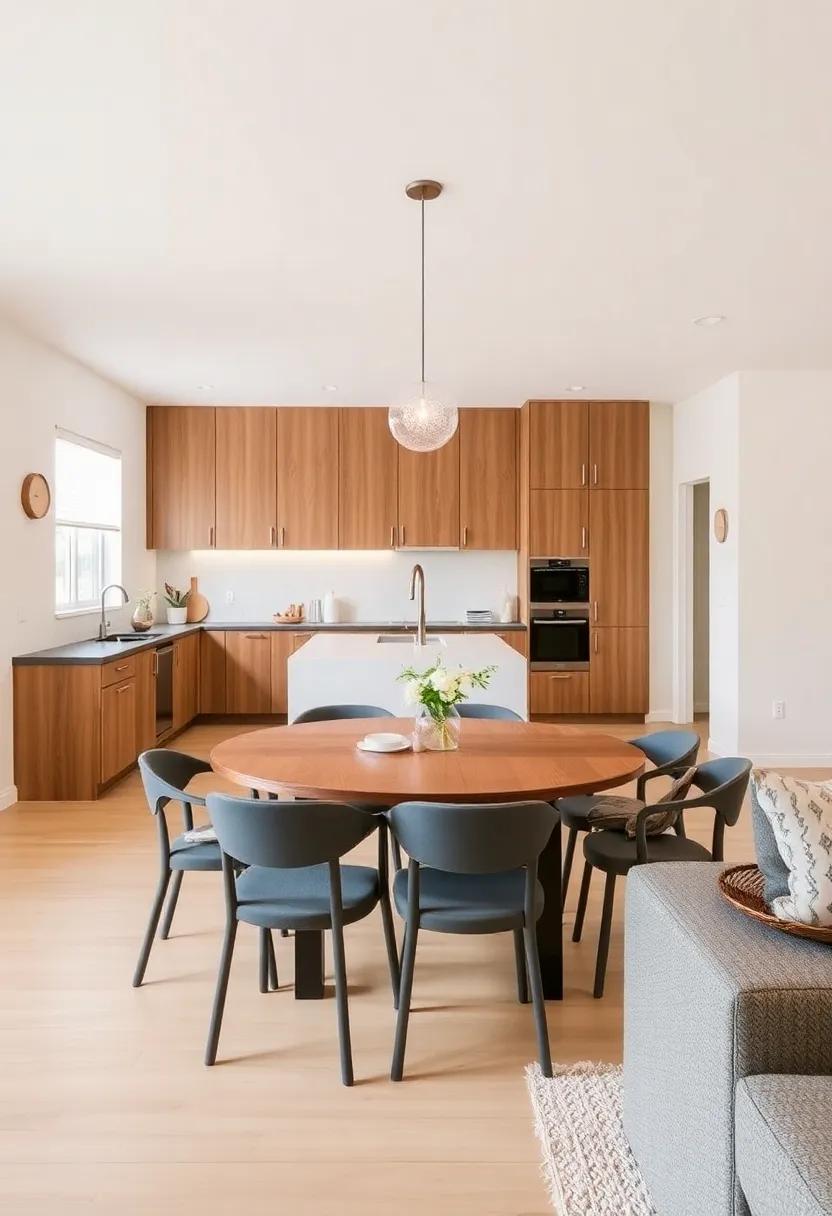
Maximizing space in an open-concept layout can be an exhilarating challenge, especially when it comes to incorporating furniture that serves multiple purposes. Pieces such as a convertible sofa can transition from a cozy seating area to an inviting guest bed with ease. Consider a dining table that doubles as a workspace. This versatile solution not only accommodates family meals but also enables a productive home office setup.
Other multifunctional elements include ottomans with hidden storage, which can function as extra seating while providing a clever solution to declutter your living area.A well-placed bar cart can seamlessly transition from a stylish accessory for entertaining guests to a mobile storage option for kitchen essentials. By thoughtfully selecting these multi-faceted pieces, you can curate a harmonious environment that is both stylish and functional. For an incredible selection of such furniture, visit Wayfair.
Strategic Zoning: Defining Areas While Maintaining Flow
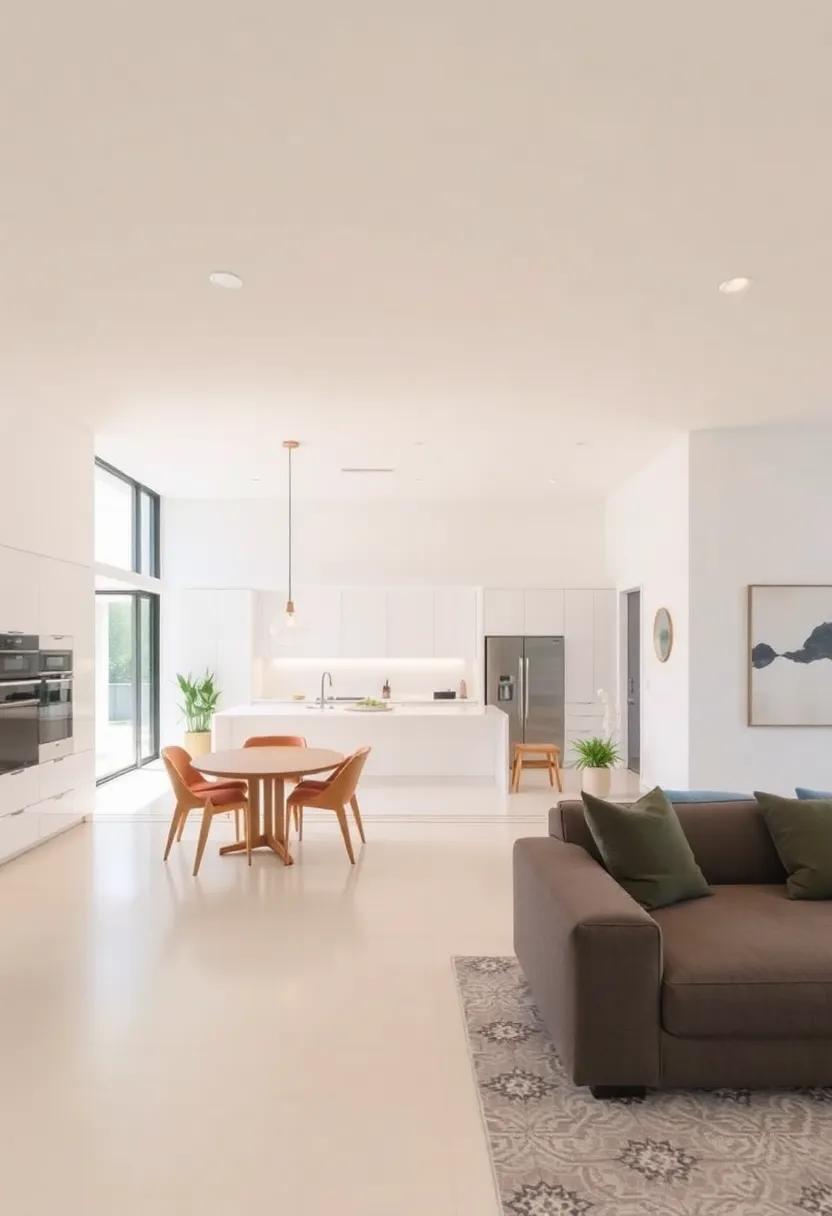
To further enrich the interconnected experience,consider integrating multifunctional furniture that can serve various purposes across spaces. such as, a dining table that doubles as a workspace, or a sofa that offers concealed storage, can maximize utility without compromising on style. Elements such as indoor plants, decorative screens, and shelving can be strategically placed to blend the distinct areas while enhancing their individuality. With careful consideration, you can achieve a stylish harmony that not only celebrates the openness of your home but also ensures each area stands out in its unique way. Explore more tips on creating cohesive living spaces at Houzz.
Incorporating Artistic Elements That Unite Spaces
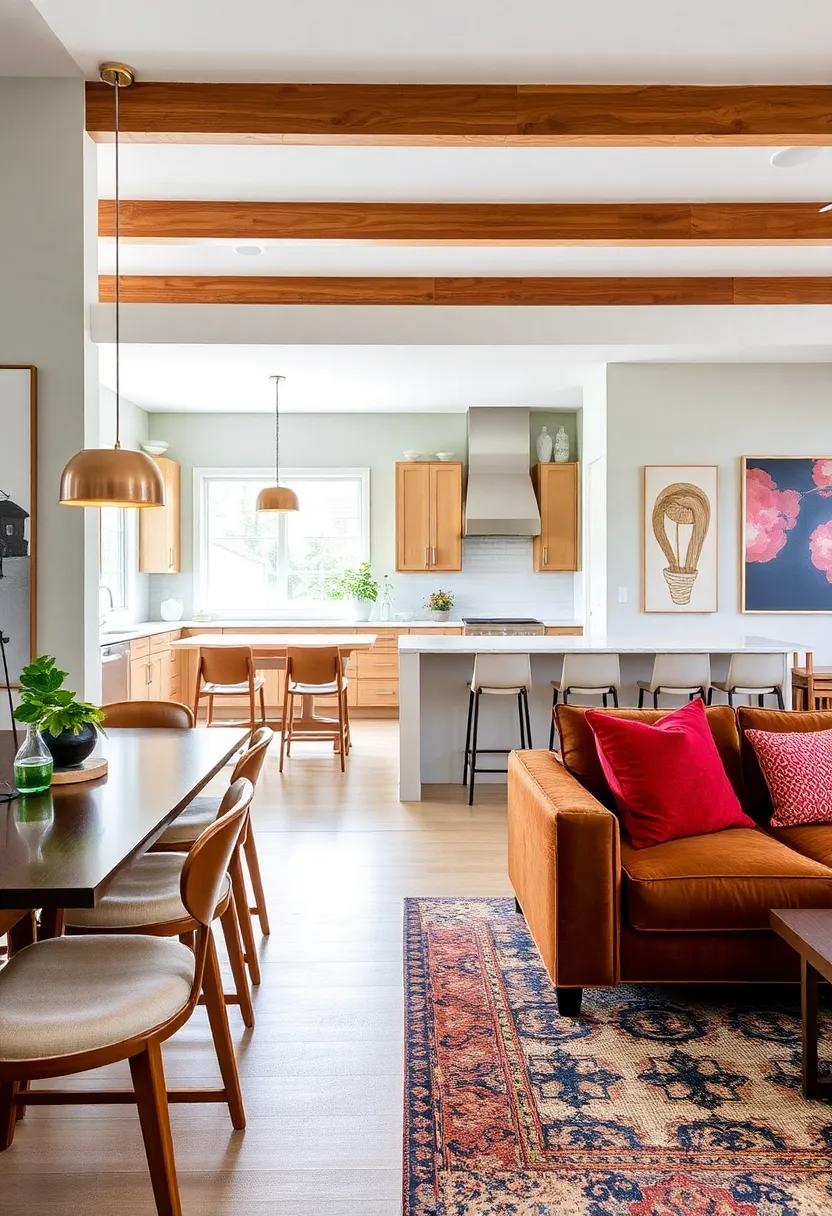
Creating a cohesive atmosphere in open spaces involves a thoughtful blend of artistic elements that foster unity. Consider integrating trademarks of your personal style through the selection of colors, textures, and art pieces that can seamlessly flow across the kitchen, dining, and living areas.Using a consistent color palette helps bridge these separate zones, allowing them to feel not just interconnected but also enhanced by the individual character each space brings to the table. Incorporating natural elements, such as plants or wooden accents, can also soften transitions while injecting vibrancy into the overall aesthetic.
In the search for artistic cohesion, one can also explore distinctive décor items that can tie various areas together. These could be a series of stylish bar stools that echo the color of your living room throw pillows or a striking pendant light that draws the eye across the kitchen and dining area. Artful additions like wall mirrors or framed artwork can promote visual flow, while multipurpose furniture enhances functionality without compromising style. Ultimately, the key is to focus on elements that resonate with your essence and showcase your artistic vision, facilitating harmony in your open living environment.For more inspiration, check out Houzz to explore various designs and ideas.
Integrating Technology Into Open Space designs Effortlessly
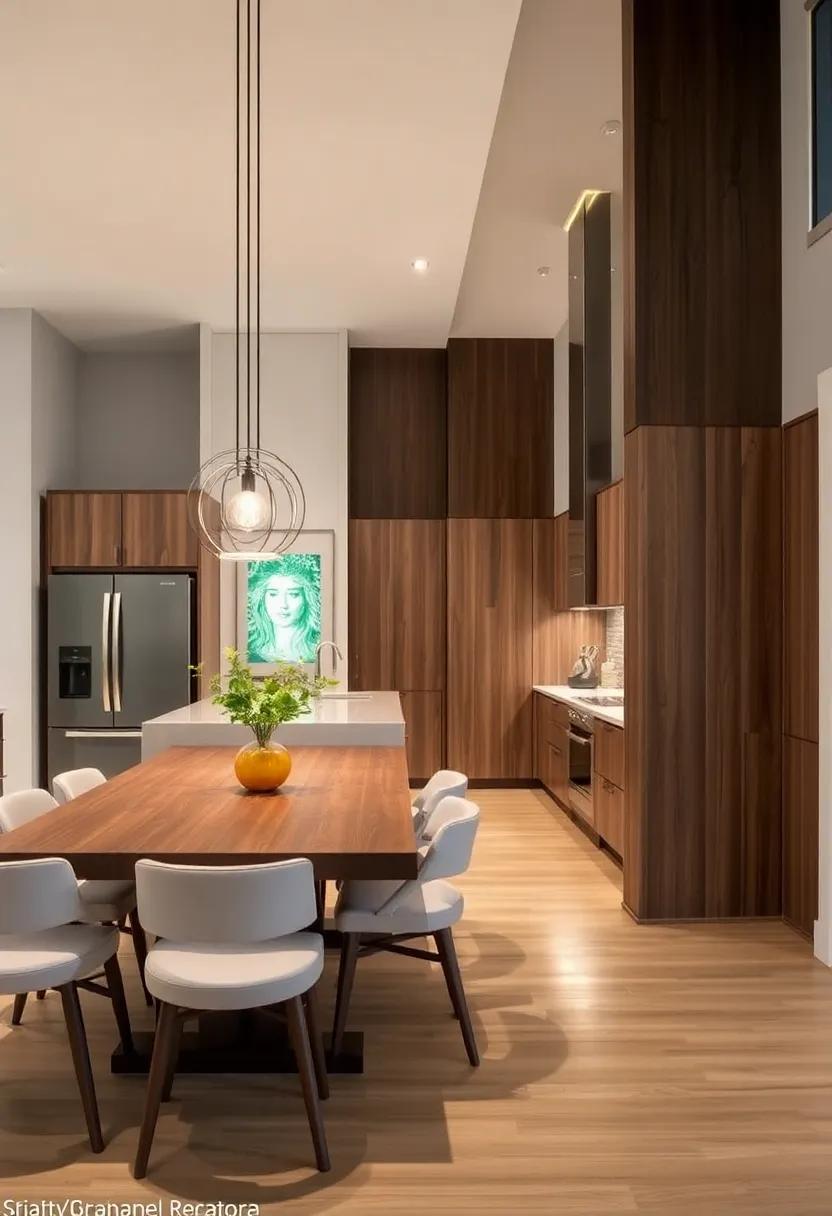
Open space designs offer a canvas for creativity, inviting a seamless blend of functionalities within kitchen, dining, and living areas. By integrating technology, these spaces can transform into smarter, more efficient environments without compromising their aesthetic appeal. Imagine featuring smart appliances that not only enhance culinary experiences but also harmonize with sleek cabinetry and stylish countertops. For instance, a connected refrigerator can suggest recipes based on the ingredients within, while built-in audio systems amplify the mood, crafting an ambiance that effortlessly transitions from casual gatherings to elegant dinners.
Moreover, incorporating innovative lighting solutions can greatly enhance the versatility of open spaces. With adjustable smart lighting, homeowners can customize the brightness and color temperature to suit various activities, promoting both relaxation and energy as needed. Utilizing wireless charging stations strategically placed throughout these areas ensures that technology does not clutter surfaces but instead integrates seamlessly into the design. The adoption of home automation systems can also streamline everyday routines, allowing for remote management of appliances and lighting. This equilibrium between functionality and style redefines how we perceive open spaces, turning them into elegant hubs of modern living. For more insight on smart home technology, visit smarthome.com.
Bringing the Outdoors In with Large Windows and Doors
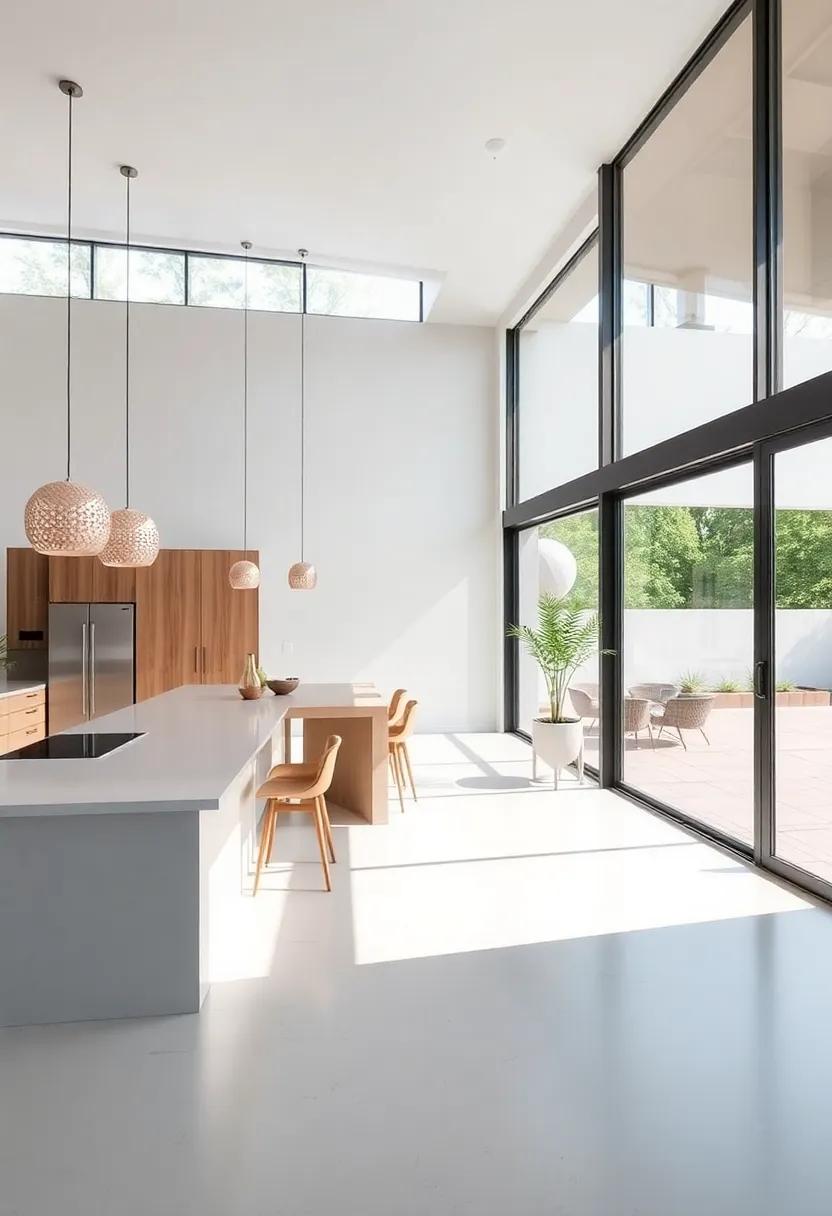
Large windows and doors can transform a home into a serene haven, seamlessly merging the interior with the great outdoors. These architectural features not only allow for an abundance of natural light, but they also create a serene ambiance that fosters well-being. Imagine sipping coffee in your kitchen as you gaze out at your blooming garden or watching the sunset from your living room while feeling the gentle evening breeze. The expansive views offered by such installations enhance the aesthetic appeal of your space, creating a visual connection to nature that can uplift your mood.
In addition to aesthetics, incorporating large openings has practical benefits that make a significant impact on everyday living. Consider these advantages:
- Enhanced natural ventilation: allowing fresh air to circulate effortlessly.
- Energy efficiency: Leveraging natural daylight can reduce reliance on artificial lighting.
- Increased property value: Homes with these features are often more desirable in the real estate market.
- Improved indoor-outdoor flow: Perfect for entertaining guests or accommodating family gatherings.
Investing in large windows and doors is not merely a design choice; it’s a lifestyle enhancement. Enhance your living experience by exploring materials and designs that reflect your personal style. For inspiration, check out Architectural Digest for the latest trends in bringing the outdoors in.
Creating Cozy Zones Within the Openness of Your Home

In the expansive canvas of an open floor plan, creating intimate and inviting nooks can transform the overall ambiance of your home. start by considering your existing furniture placement; utilize sofas and armchairs to delineate spaces without sacrificing flow. Incorporate elements such as soft throw pillows, warm blankets, and low coffee tables to foster a sense of comfort. Adding area rugs helps to anchor each zone, visually signaling to both residents and guests that it’s time to relax and unwind. Don’t forget the power of lighting—strategically placed table lamps or string lights can create a warm glow that beckons people to settle in.
To further enhance the cozy vibes, introduce natural elements such as houseplants or a small indoor herb garden in the kitchen area.By integrating personal touches, like family photos or cherished books, into your decor, you create a space that feels uniquely yours. Consider this essential checklist for your cozy zones:
- Soft textiles: Incorporate cushions and throws for added warmth.
- Warm lighting: Opt for dimmable fixtures to create ambiance.
- Natural materials: Use wood, stone, and plants to bring the outdoors in.
- Personal decor: Add elements that reflect your taste and history.
For more inspiration on interior design and creating harmonious spaces, visit House Beautiful.
Designing with Textures: Soft Furnishings for Warmth
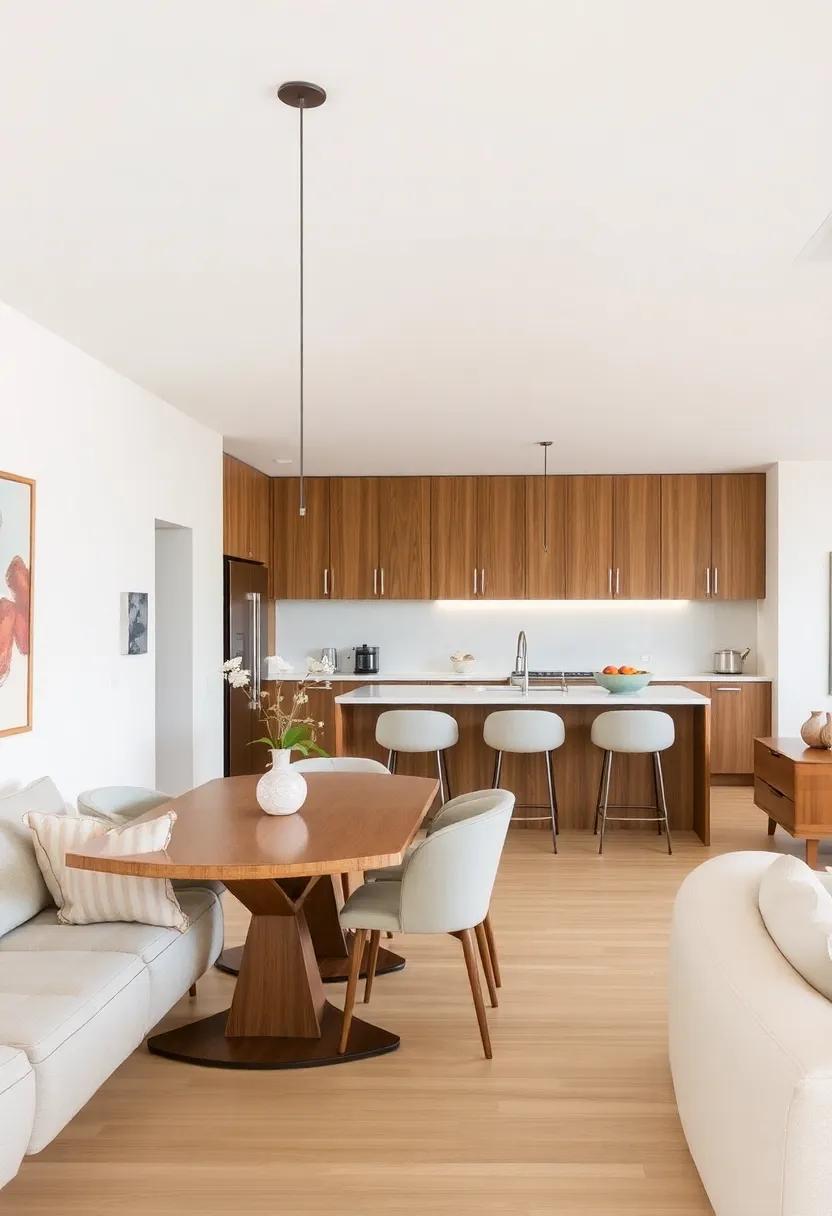
Incorporating textures into your open-concept living spaces can significantly enhance the overall warmth and comfort of your home. Soft furnishings,such as plush cushions,woven throws,and sumptuous rugs,not only add visual interest but also create an inviting atmosphere. When designing your kitchen,dining,and living areas,consider using a mix of materials like cotton,linen,and velvet to achieve a harmonious look. Here are some textures to incorporate:
- Knitted Throws: Perfect for adding a cozy touch to any seating area.
- Patterned Pillows: Use bold designs to create focal points in your decor.
- Cotton or Jute Rugs: They bring warmth and can define separate zones in an open space.
To elevate these elements even further, layering textures can create depth and intrigue. Such as, pairing a sleek leather sofa with soft, patterned pillows invites comfort without sacrificing style. Accent furniture, such as a wooden coffee table, can provide contrasting textures that complete the look, while also serving functional purposes. Consider the impact of color, as well; earth tones can enhance the warm feel, while splashes of cooler hues can keep the environment balanced and fresh. A visual guide can help you choose your textures effectively:
| Texture | Key Feature |
|---|---|
| Velvet | Luxurious feel |
| wool | Warmth and durability |
| Silk | Smooth and shiny |
| Canvas | Rugged yet chic |
By thoughtfully selecting and layering different textures, you not only create a visually appealing environment but also a space where family and friends feel at home. For more information on design principles, check out Architectural Digest.
Color Coordinating Across Spaces for Visual Coherence
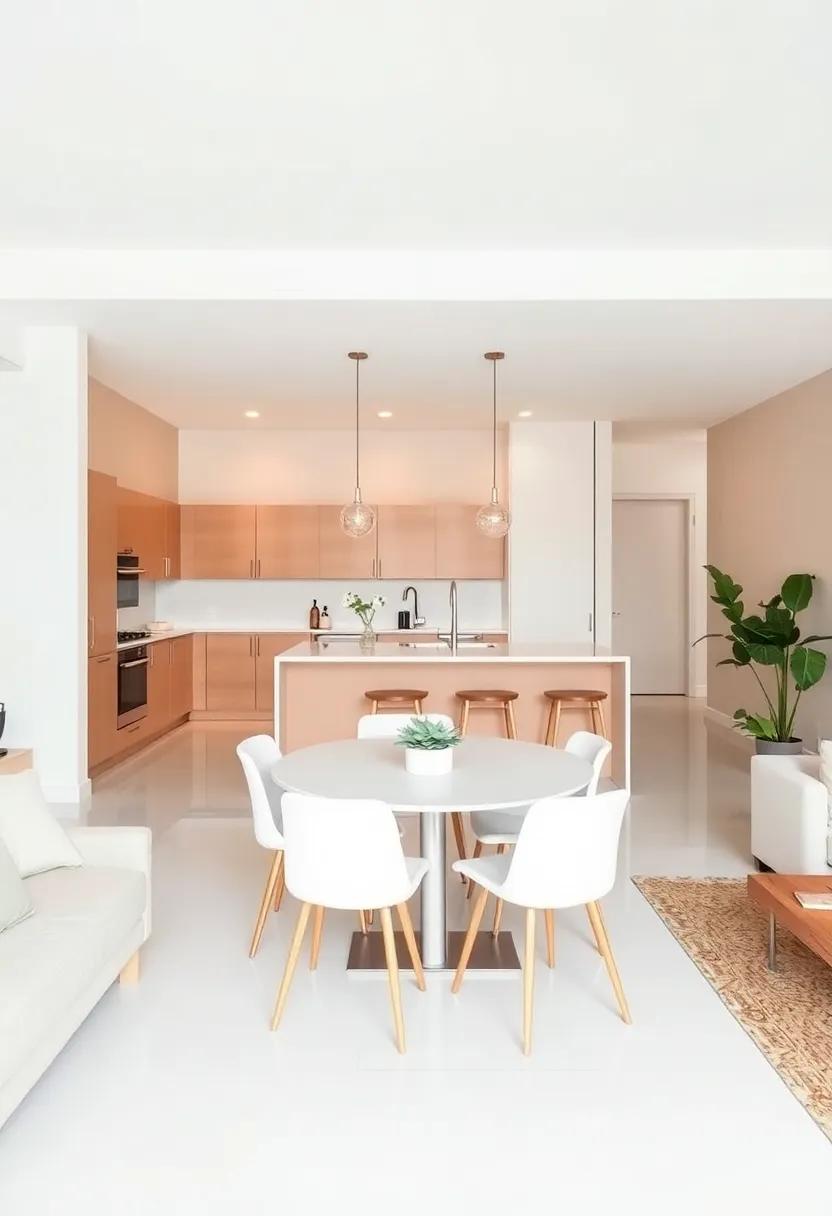
Creating a visually cohesive environment in open spaces like kitchens, dining areas, and living rooms requires a thoughtful approach to color coordination. To achieve this harmony, consider starting with a dominant color that sets the tone for your space.This might be a muted neutral like soft beige or a bolder choice, like deep navy. Onc the dominant color is established, choose complementary accents that elevate the overall design without overwhelming the eye. Think about incorporating colors from the same family or ones that create a natural contrast, such as greens paired with earthy browns or pastel blues accented by crisp whites. Each area can have a distinct personality while still feeling connected through shared hues and tones.
To enhance visual intrigue while maintaining coherence, implementing a color palette throughout your spaces becomes essential. This can be done through the use of decor items such as cushions, tableware, and wall art that reflect your chosen scheme.You might also consider the material finishes—like matte or gloss—that can influence the perception of color. Using a simple table to illustrate your colors can help visualize this concept effectively:
| Space | Dominant Color | Accent Color |
|---|---|---|
| Kitchen | Soft Beige | Fresh Green |
| Dining Room | Deep Navy | Crisp White |
| Living Room | Warm Taupe | Burnt Orange |
Additionally, don’t shy away from using patterned textiles or statement pieces to tie the spaces together, ensuring they reference the color scheme established. Try visiting Houzz for inspiration on integrating cohesive color palettes into your home’s open layout seamlessly.
Selecting the Right Flooring to Link All Areas Together
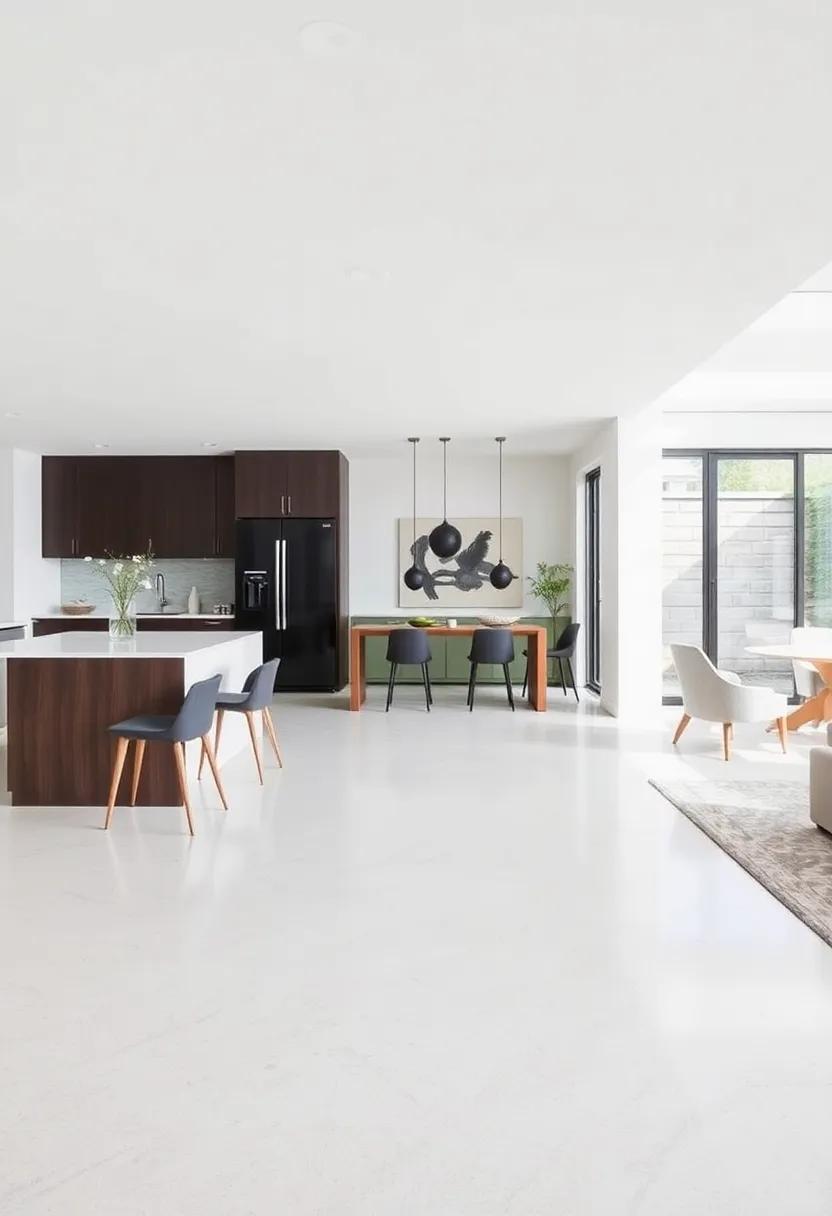
Choosing the right flooring can make or break the continuity of your open living, dining, and kitchen spaces.To create a seamless flow throughout your home, consider materials that not only complement each other but also suit the functional needs of each area. Wood or laminate flooring is an excellent choice for uniformity, offering a warm touch that can tie together distinct zones. Alternatively,luxury vinyl planks or tiles provide versatility,durability,and a wide range of designs,allowing for the desired aesthetic without sacrificing practicality.
As you evaluate your options, think about color palettes and textures that work in harmony. Here are some tips to guide you in making the right decision:
- Choose a consistent color scheme: Lighter shades can help to brighten the space.
- incorporate area rugs: Use rugs to define specific areas while maintaining a cohesive look.
- consider maintenance: Opt for materials that are easy to clean and maintain, especially in the kitchen.
| Flooring Type | Pros | cons |
|---|---|---|
| Wood | Timeless appeal, warmth | Can be easily scratched, requires upkeep |
| Laminate | Cost-effective, easy installation | Less authentic feel, may fade |
| Luxury Vinyl | Water-resistant, diverse design | Can be less durable than real wood |
By harmonizing your flooring choices, you create an open space that flows naturally, enhancing both function and style. for additional inspiration and ideas, visit Houzz.
Showcasing Personal Style Through Decor and Arrangement
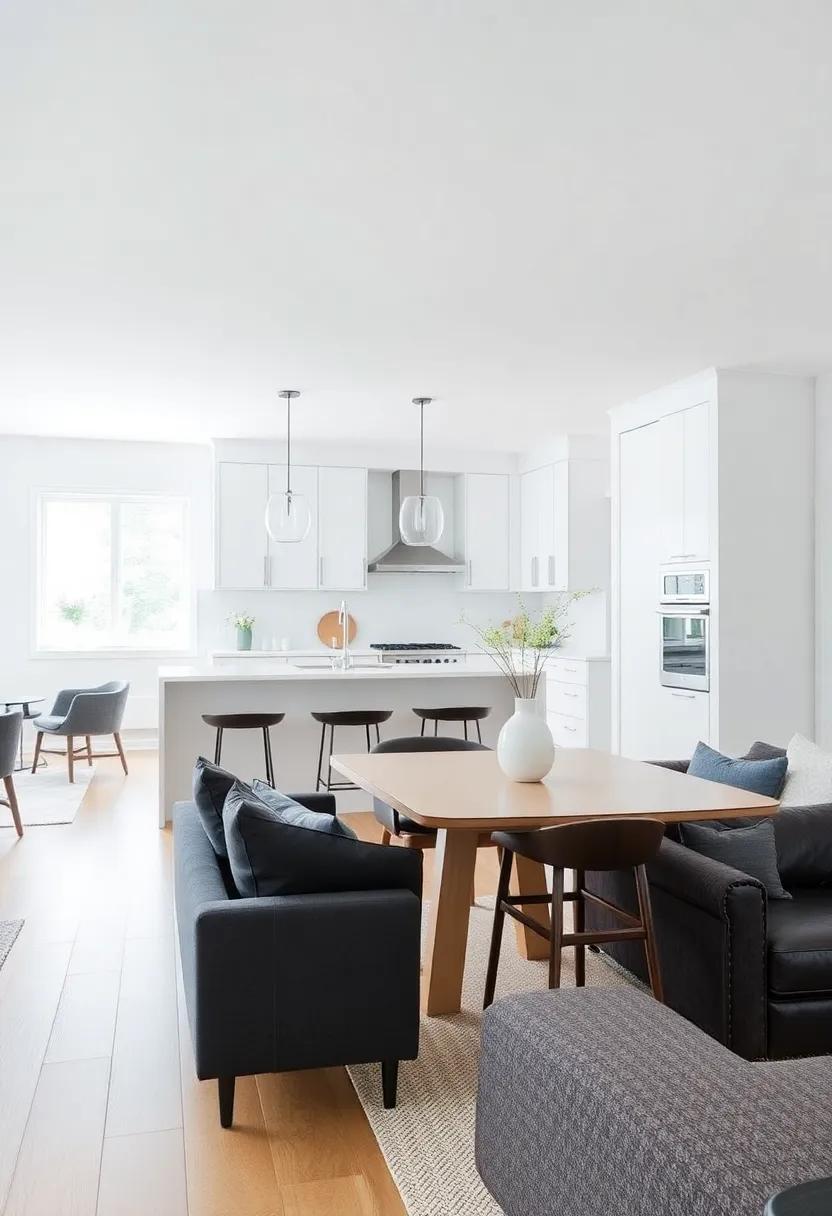
Transforming your open living space into a personal haven starts with thoughtful decor choices and strategic arrangements that reflect your unique style. imagine a seamless flow where the kitchen, dining, and living areas merge beautifully, creating an inviting atmosphere that enhances everyday experiences. Color palettes play a crucial role; choose harmonious hues that transition smoothly between spaces. To add character, incorporate statement pieces like bold artwork or handcrafted furniture that draws the eye and tells a story about who you are. Layering textures, from plush cushions to sleek tableware, will amplify the sensory experience, inviting guests to engage in the warmth of your home.
To elevate the functionality of your open space while maintaining style,consider defining each area with purposeful arrangements. Utilize area rugs to demarcate zones, such as a cozy seating nook in the living area or an inviting dining setup. Integrate multifunctional furniture, like a dining table that expands for gatherings, or a stylish sideboard that doubles as storage, ensuring Elegance without clutter. Moreover, plants can serve as natural dividers, bringing a vibrant touch to any corner. For more inspiration on harmonizing your home decor, visit The Spruce to explore trends that can help you achieve the perfect blend of personal style and open-space elegance.
Enhancing Acoustics in Open Concept Living environments
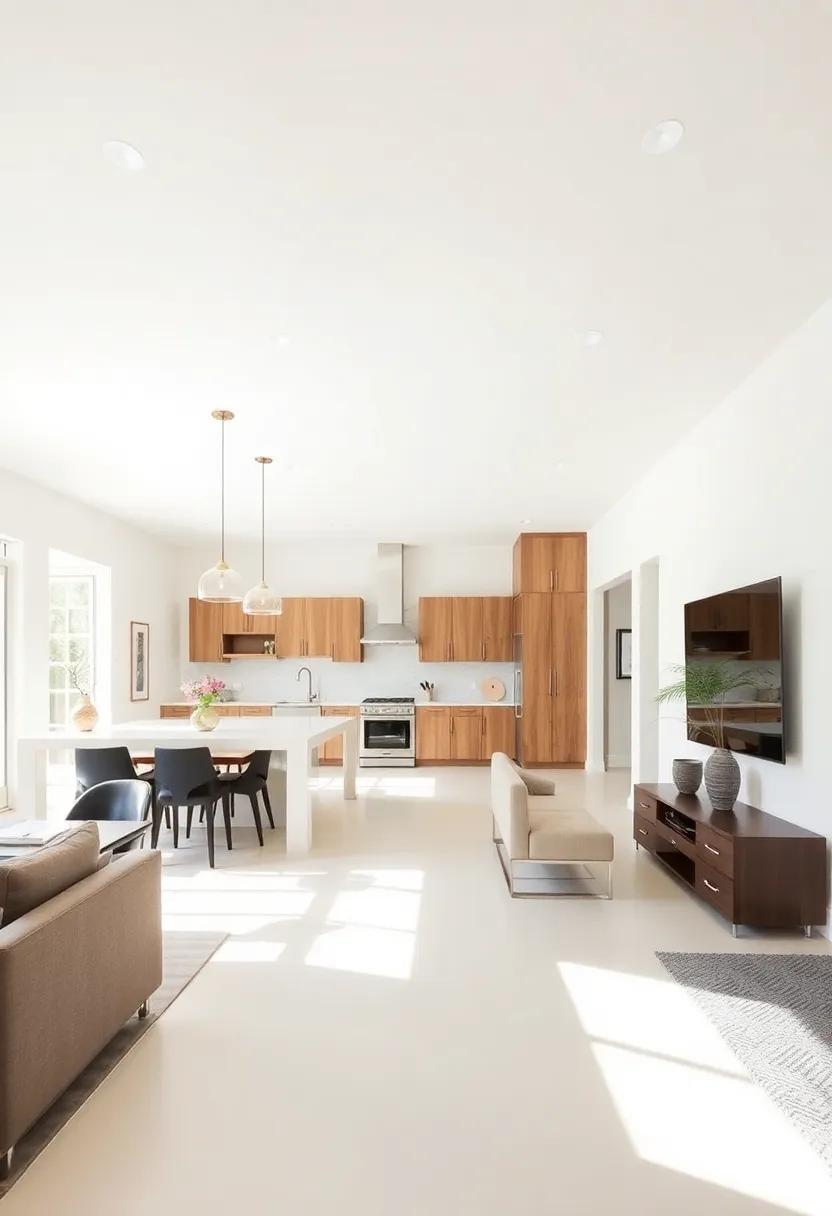
Open concept living environments, while celebrated for their spatial flow, often face the challenge of sound management. To create a serene atmosphere amidst the vibrancy of combined living spaces, consider integrating a variety of sound-absorbing materials.Textiles like plush rugs and thick curtains can significantly reduce echoes and soften noise from daily activities. Additionally, incorporating acoustic panels as wall art not only enhances the visual charm but actively engages sound absorption. By utilizing furniture with built-in acoustics, such as upholstered sofas or bookshelves lined with soft decor, you also enhance comfort and privacy.
Another creative approach involves strategic zoning through sound-dampening partitions. Furniture can double as separators; as a notable example, a tall bookshelf acts as a barrier while providing space for decor. Plants serve a dual purpose too—not only do they breathe life into the environment, but they also contribute to sound diffusion. To see how various elements can harmonize to foster an acoustic-friendly environment, a tailored design can be explored.Here’s an example of how different materials can work together:
| Material | Function | Suggested Use |
|---|---|---|
| Rugs | Sound Absorption | Living room and dining area |
| Acoustic Panels | Sound Diffusion | Wall decor in communal areas |
| Foliage | Noise Masking | Various spots, especially corners |
For further inspiration on enhancing acoustics in your open space, explore resources at acoustics.com.
Choosing the Right Plants to Complement Open Spaces
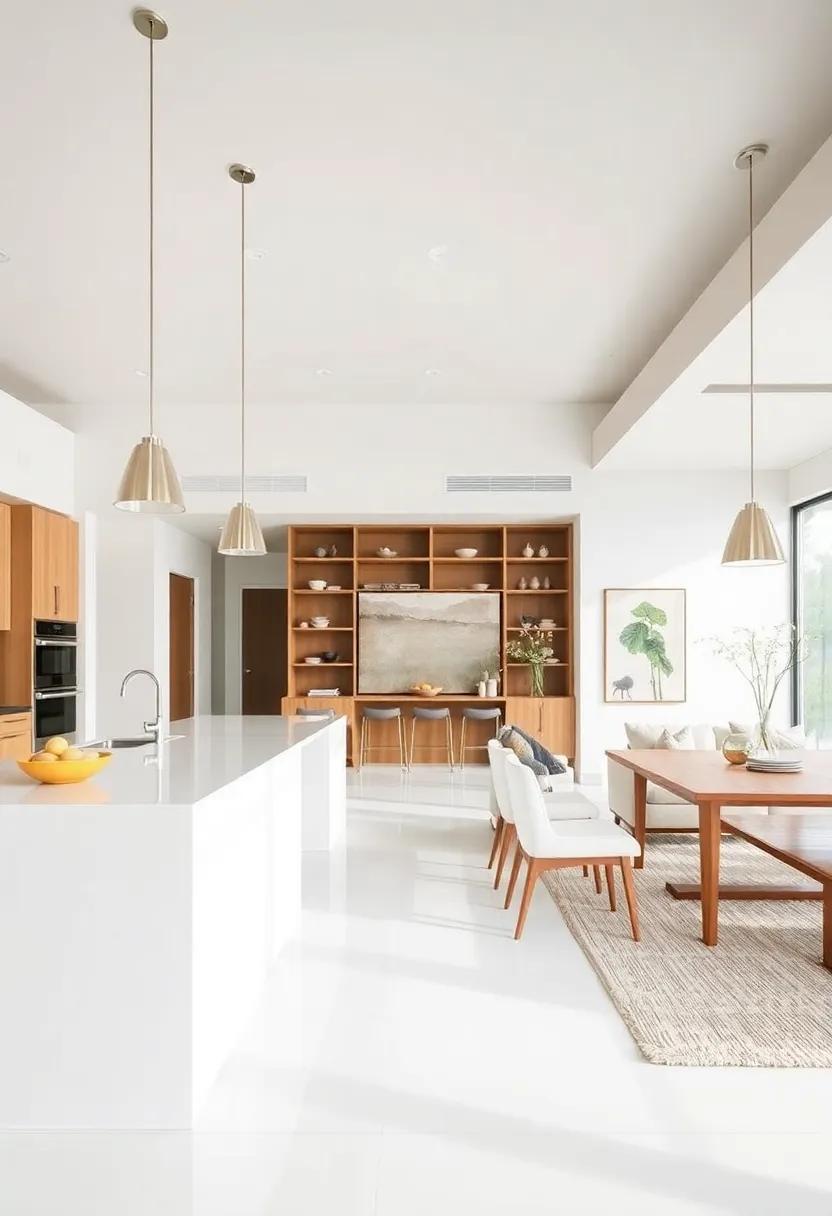
When considering the ideal foliage to enhance open spaces, it’s essential to focus on plants that not only suit the environment but also create a seamless flow between your kitchen, dining, and living areas. Variety is key, as a mix of height, texture, and color can add visual interest and establish a cohesive look. Incorporating strategically selected plants can soften hard lines and add warmth to the interiors. For instance, using tall leafy greens in corners or low-maintenance succulents on countertops achieves elegance while ensuring ease of care.
To achieve the best balance, think about the light conditions and aesthetic goals of your space. Here are some plant types that thrive in indoor environments:
- Low Light: Snake Plant, Pothos
- Moderate Light: Fiddle leaf Fig, Rubber Plant
- Bright Light: Succulents, Cacti
Complementing your open-concept design with the right plants can transform the ambiance into one of warmth and tranquility.You can explore more ideas and tips about plant selection on the Sill for expert guidance.
Sustainable Material Choices for eco-Friendly Open Living
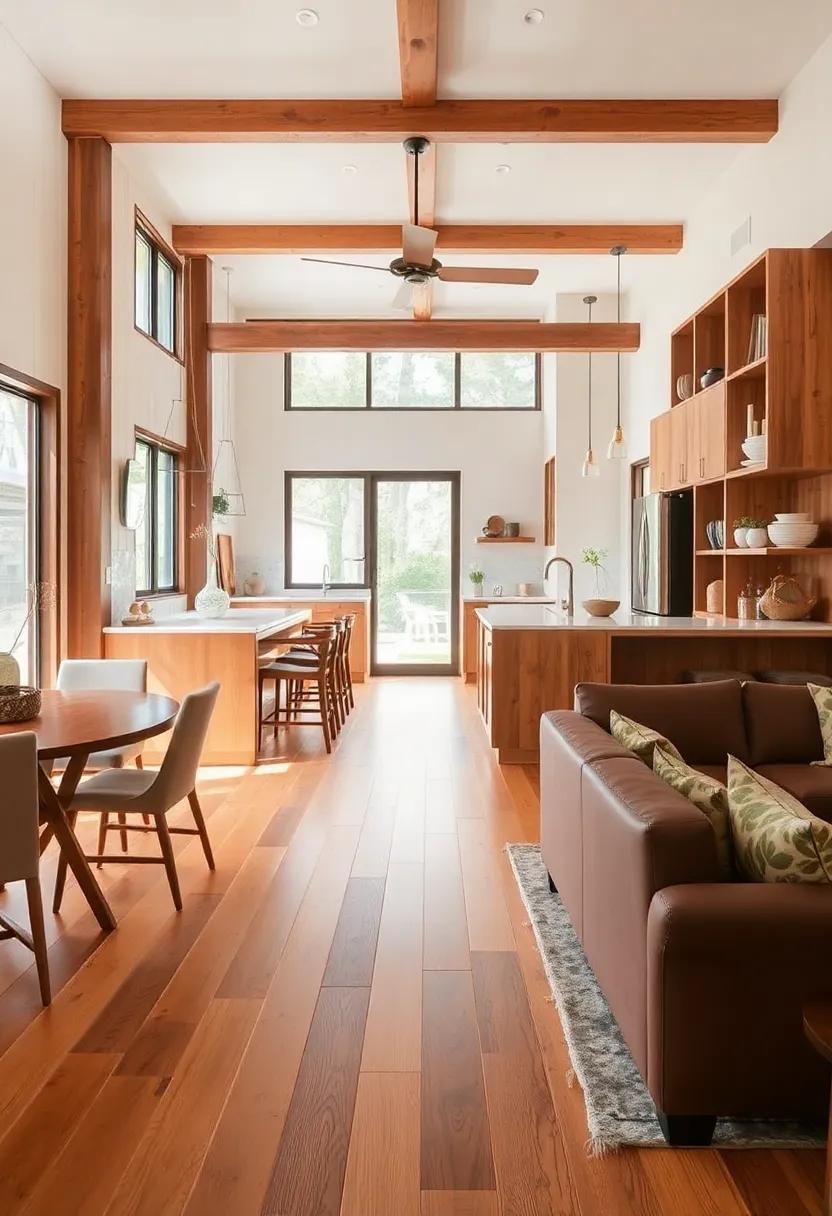
When creating an eco-friendly open living environment, the choice of materials plays a critical role in minimizing environmental impact while enhancing aesthetic appeal. Opting for recycled, renewable, and non-toxic materials not only reduces waste but also promotes healthier indoor air quality.Homeowners can consider materials such as:
- Bamboo: A fast-growing grass that requires minimal resources to cultivate.
- Reclaimed Wood: Salvaged from old structures, offering unique character while conserving forests.
- Recycled Glass: Perfect for countertops and tiles, providing a striking visual effect.
- Low-VOC Paints: Ensuring a safer living space with reduced harmful emissions.
Combining these sustainable materials not only contributes to a healthier planet but also creates a harmonious and stylish design. For instance, a blend of reclaimed wood cabinetry and bamboo flooring can seamlessly connect the kitchen, dining, and living areas while ensuring a cohesive look.Implementing a strategy for sourcing locally can enhance these benefits, as it supports local economies and reduces transportation emissions. An example of such a commitment can be seen in organizations like Green Building Advisor, which provide resources and guidance for sustainable building practices.
Personalizing Open Areas with Unique Art and Accessories

Transforming open areas into personalized havens starts with selecting art and accessories that resonate with your style. Think bold canvases that command attention, or subtle sculptures that whisper elegance. Consider incorporating a mix of textures and colors to create visual interest and a sense of depth. Accessories such as vintage finds, handmade ceramics, and eco-friendly decor can evoke warmth and character, making these spaces feel uniquely yours. Don’t shy away from layering different elements, like woven baskets paired with sleek metals, to cultivate a balanced aesthetic that speaks to both comfort and sophistication.
In addition to decor, the arrangement of furniture plays a pivotal role in personalizing your open spaces. Utilize area rugs to define zones, and choose furniture that complements your artistic choices. You can also create a focal point by placing a striking piece of art above a chic sideboard or by using a feature wall painted in a bold hue. To further enrich the ambiance, incorporate natural elements, like houseplants or floral arrangements, which bring life and freshness into the mix. For inspiration on unique decor options, explore websites like Etsy where you can find handmade and vintage treasures that can elevate your space.
Understanding Flow: The Importance of Traffic Patterns
Creating a seamless transition between the kitchen, dining, and living areas is essential for fostering a cohesive and inviting atmosphere. By understanding how traffic flows through these spaces,we can enhance both function and aesthetics. Consider the following elements that contribute to effective traffic patterns:
- Clear Pathways: Ensure ther’s enough room for movement between zones, allowing for easy navigation.
- Defined Zones: Utilize furniture placement to establish boundaries, making each area feel distinct yet connected.
- Open Sight Lines: Opt for low or obvious furniture to maintain visibility and open communication among spaces.
Incorporating these elements not only optimizes traffic flow but also enriches the overall living experience. It’s essential to keep in mind the rhythm that these spaces create together, almost like a well-choreographed dance. Choose materials and colors that harmonize, tying the design together while allowing each area to breathe individually. For inspiration on how to achieve this seamless flow, you can explore House Beautiful for tips and trends in open-concept design.
Innovative storage Solutions for Clutter-Free Spaces
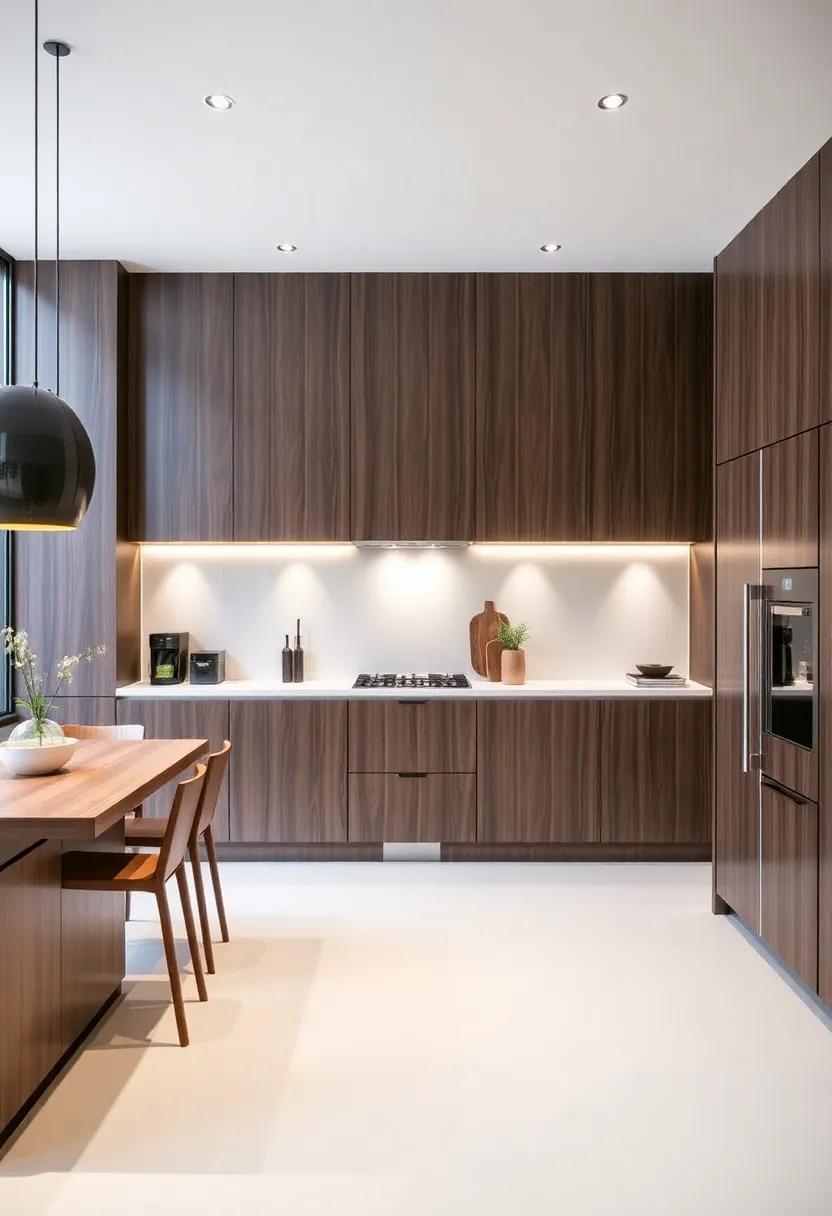
In the quest for a seamless blend between kitchen, dining, and living areas, innovative storage solutions emerge as crucial players in maintaining an organized and clutter-free environment. Consider incorporating multi-functional furniture that maximizes utility without compromising on style.Stools that double as storage bins, coffee tables featuring hidden compartments, and extendable dining tables can seamlessly adapt to changing needs while ensuring everything has its designated place. This approach not only enhances the aesthetic appeal of open spaces but also fosters practical arrangements perfect for daily living.
Wall-mounted shelves are another game-changer, allowing for the display of decorative items while providing additional storage without consuming valuable floor space. Utilize these shelves for a mix of books, plants, and kitchen essentials, creating a visually dynamic presentation.For a bit of extra charm, consider using stylish baskets or decorative boxes to house smaller items, keeping them tucked away yet easily accessible. Furthermore, opting for transparent storage solutions, such as glass jars, can create the illusion of space while highlighting contents in a chic manner. Explore more ideas at houzz.com to bring your vision of a functional,inviting living area to life.
Highlighting Architectural Features That Define Open Spaces
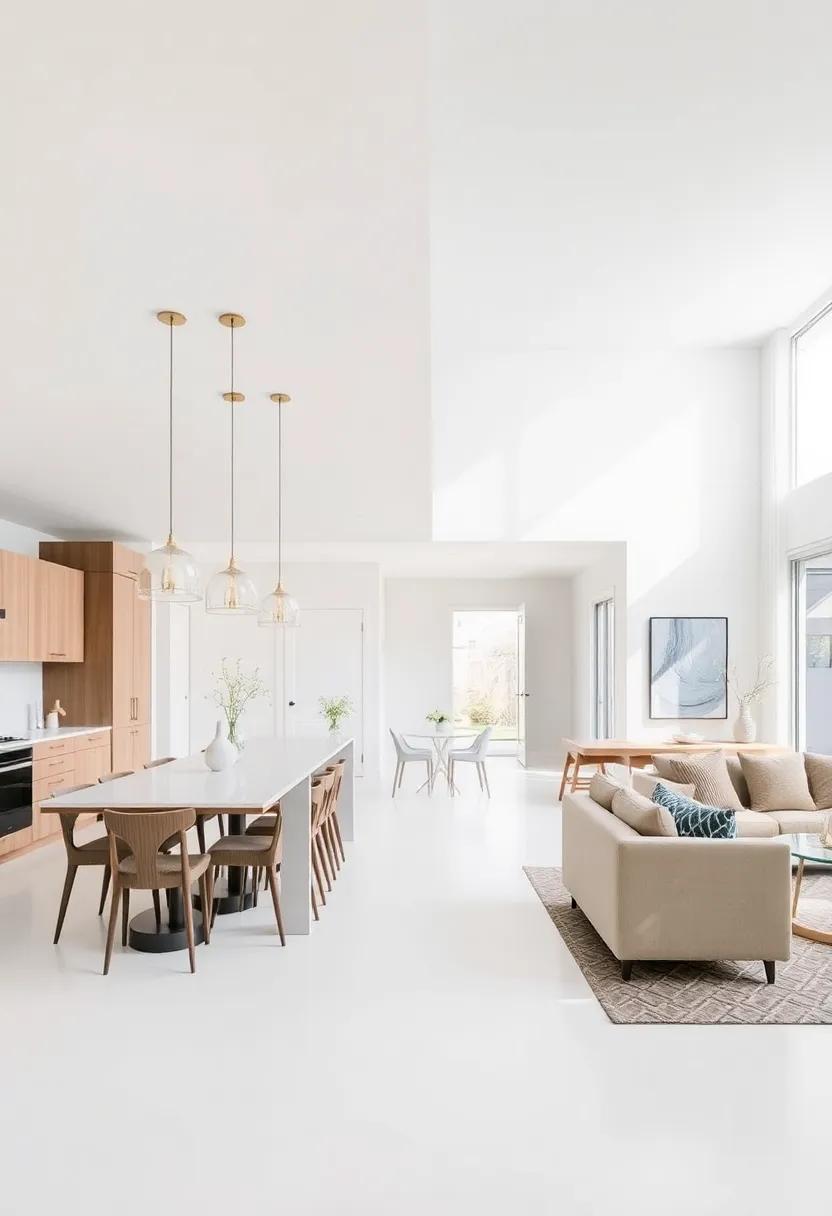
Open spaces masterfully blend functionality and aesthetics, creating environments that evoke comfort and creativity. One defining characteristic is the use of natural light, which floods the area through expansive windows and skylights, establishing a connection with the outdoors. This interplay between shadow and light enhances the three-dimensionality of the space, making it feel larger and more inviting. Additionally, the flow between spaces—where kitchen, dining, and living areas seamlessly interact—allows for both movement and conversation. Elements such as integrated flooring and strategically placed furniture elevate this connectivity, leading to a cohesive design that celebrates the essence of communal living.
Materials and textures play a pivotal role in defining the overall atmosphere of these open areas. Industrial accents, such as exposed beams or brick walls, can juxtapose warmer elements like wooden furniture, creating a layered visual experience.complementing these features, color palettes often encompass soft, neutral tones, contributing to a tranquil environment conducive to relaxation and socialization.To enhance acoustics, decorative elements such as rugs and wall hangings can be thoughtfully incorporated to absorb sound and support a harmonious ambiance. the design of open spaces thrives on a deliberate choice of features that promote both style and functionality, ensuring an enjoyable, multi-faceted living experience. For further insights on open floor concepts, visit Houzz.
Inspiration from Global Design Trends in Open Living Concepts
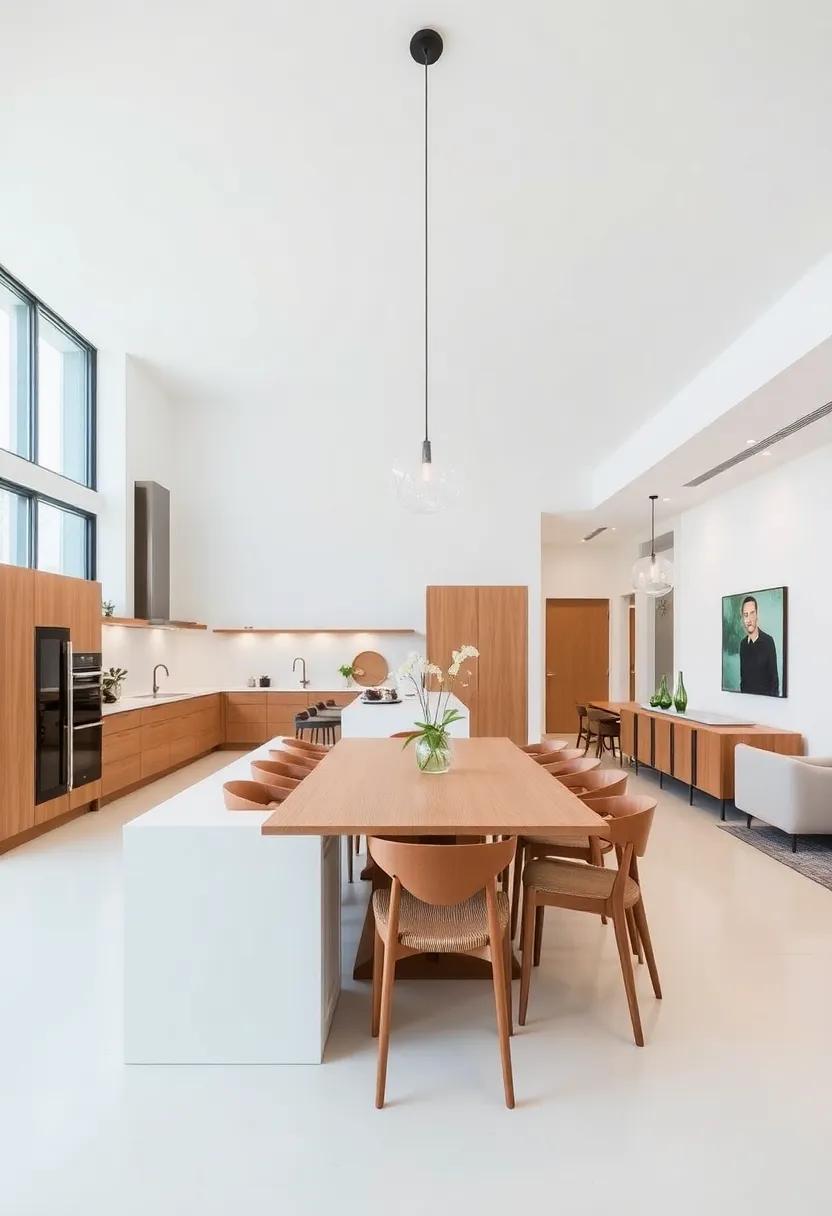
Global design trends are continually evolving, prompting a shift towards more open living concepts that blur the lines between kitchen, dining, and living spaces. This integration creates a seamless flow that not only enhances functionality but also fosters interaction among family and friends. Natural materials such as wood and stone take center stage, bringing warmth and an organic touch to modern interiors. Coupled with an emphasis on large windows and natural light, these elements inspire a sense of connection with the outdoors, making spaces feel more expansive and inviting.
As we embrace these trends, consider integrating a few key features into your open living design:
- Multi-functional furniture: Pieces that serve multiple purposes to maximize space and usability.
- Cohesive color schemes: A unified palette that flows through the entire area to create visual harmony.
- Defined zones: Use area rugs or lighting to designate different functional areas without interrupting the open feel.
To explore more ideas on global design trends, check out Houzz, a great resource for inspiration and practical tips.
To Wrap it Up
embracing open spaces within our homes is more than just a design choice; it’s a lifestyle that celebrates connection, functionality, and aesthetic appeal.The seamless flow between kitchen, dining, and living areas invites us to gather, converse, and create lasting memories amidst a backdrop of stylish harmony. As you embark on your own journey to reimagine these spaces, remember that each element you choose can contribute to an ambiance that reflects your personality and values. Whether it’s the warmth of natural materials, the inclusion of personal touches, or the thoughtful layout that encourages interaction, every detail matters. Let your home resonate with the beautiful balance of style and purpose, and may it always be a space where culinary delights, shared meals, and laughter unite under one expansive roof. Embrace the possibilities and watch as your open spaces transform into a vivid tapestry of life, love, and togetherness.
 theFASHIONtamer Where Style Meets Space, Effortlessly
theFASHIONtamer Where Style Meets Space, Effortlessly 